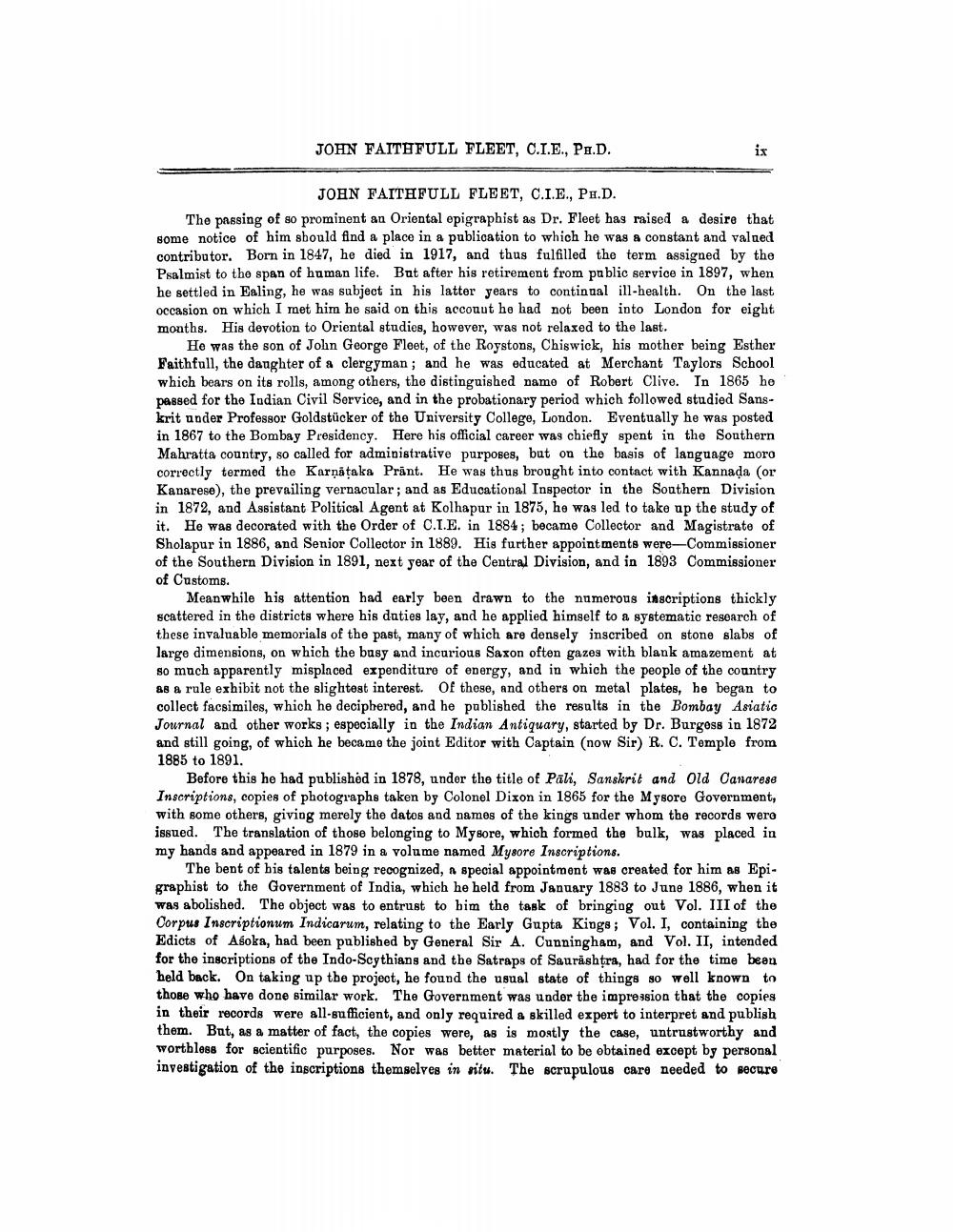________________
JOHN FAITHFULL FLEET, C.I.E., Pa.D.
JOHN FAITHFULL FLEET, C.I.E., Ph.D. The passing of so prominent an Oriental epigraphist as Dr. Fleet has raised a desire that some notice of him should find a place in a publication to which he was a constant and valued contributor. Born in 1847, he died in 1917, and thus fulfilled the term assigned by the Psalmist to the span of human life. But after his retirement from public service in 1897, when he settled in Ealing, he was subject in his latter years to continual ill-health. On the last occasion on which I met him he said on this accouut he had not been into London for eight months. His devotion to Oriental studies, however, was not relaxed to the last.
He was the son of John George Fleet, of the Roystons, Chiswick, his mother being Esther Faithfull, the daughter of a clergyman; and he was educated at Merchant Taylors School which bears on its rolls, among others, the distinguished name of Robert Clive. In 1865 ho passed for the Indian Civil Service, and in the probationary period which followed studied Sanskrit under Professor Goldstücker of the University College, London. Eventually he was posted in 1867 to the Bombay Presidency. Here his official career was chiefly spent in the Southern Mahratta country, so called for administrative purposes, but on the basis of language moro correctly termed the Karņātaka Prant. He was thus brought into contact with Kannada (or Kanarese), the prevailing vernacular; and as Educational Inspector in the Southern Division in 1872, and Assistant Political Agent at Kolhapur in 1875, he was led to take up the study of it. He was decorated with the Order of C.I.E. in 1884; became Collector and Magistrate of Sholapur in 1886, and Senior Collector in 1889. His further appointments were-Commissioner of the Southern Division in 1891, next year of the Central Division, and in 1893 Commissioner of Customs.
Meanwhile his attention had early been drawn to the numerous inscriptions thickly scattered in the districts where his daties lay, and he applied himself to a systematic research of these invaluable memorials of the past, many of which are densely inscribed on stone slabs of large dimensions, on which the basy and incurious Saxon often gazes with blank amazement at so much apparently misplaced expenditure of energy, and in which the people of the country as a rule exhibit not the slightest interest. Of these, and others on metal plates, he began to collect facsimiles, which he deciphered, and he published the results in the Bombay Asiatic Journal and other works; especially in the Indian Antiquary, started by Dr. Burgess in 1872 and still going, of which he became the joint Editor with Captain (now Sir) R. C. Temple from 1885 to 1891.
Before this he had published in 1878, under the title of Pali, Sanskrit and Old Canarese Inscriptions, copies of photographs taken by Colonel Dixon in 1865 for the Mysore Government, with some others, giving merely the datos and names of the kings under whom the records were issued. The translation of those belonging to Mysore, which formed the bulk, was placed in my hands and appeared in 1879 in a volume named Mysore Inscriptions.
The bent of his talents being recognized, a special appointment was created for him as Epigraphist to the Government of India, which he held from January 1883 to June 1886, when it was abolished. The object was to entrust to bim the task of bringing out Vol. III of the Corpus Inscriptionum Indicarum, relating to the Early Gupta Kings; Vol. I, containing the Edicts of Asoka, had been published by General Sir A. Cunningham, and Vol. II, intended for the inscriptions of the Indo-Scythians and the Satraps of Saurashtra, had for the time been held back. On taking up the project, he found the usual state of things so well known to those who have done similar work. The Government was under the impression that the copies in their records were all-sufficient, and only required a skilled expert to interpret and publish them. But, as a matter of fact, the copies were, as is mostly the case, untrustworthy and wortbless for scientific purposes. Nor was better material to be obtained except by personal investigation of the inscriptions themselves in situ. The scrupulous care needed to secure




